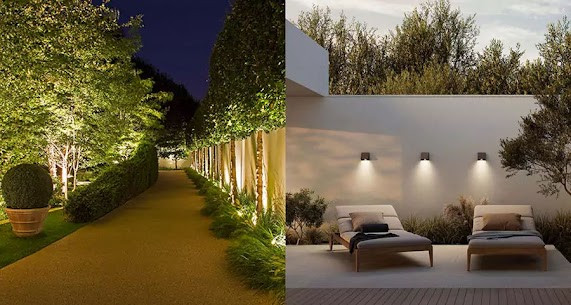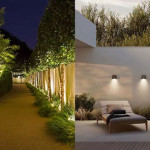Lighting can change how your outdoor space looks and feels, especially at night. Whether you’re hosting a backyard BBQ, relaxing on the patio, or just pulling into the driveway, having the right lighting system makes everything more inviting. But when it comes to choosing a landscape lighting installation company in Raleigh, there’s one big question: Should you go with uplighting or downlighting?
Let’s explore both and help you decide what works best for your home in Raleigh and the surrounding areas.
What’s the Difference Between Uplighting and Downlighting?
What Is Uplighting?
Uplighting is when lights are placed on the ground and aimed upward. These lights shine up at trees, walls, or anything you want to show off. It creates drama and depth by bringing out shadows and cool shapes, making everything stand out more.
Uplighting is great for highlighting focal points like tall trees, water features, or the unique parts of your house. It can also boost your curb appeal, giving your home a nice, polished look even after the sun goes down.
What Is Downlighting?
Downlighting is the opposite. These lights are placed above—on trees, rooftops, or posts—and shine downward. They give off a soft, calm glow that feels a lot like moonlight.
Downlighting is great for lighting up patios, walkways, and steps so people can see where they’re going at night. It’s also good for covering bigger areas like driveways or large yards without being too bright or harsh.
Before you get too far into choosing between uplighting and downlighting, it’s smart to understand how different fixtures, angles, and placements impact your results. A lot of Raleigh homeowners jump into outdoor lighting projects without realizing how much thought needs to go into the design.
If you’re planning your setup, take a few minutes to review some practical tips local homeowners should know before getting started—it can make a big difference in both the look and performance of your system.
Which One Looks Better for Raleigh Homes?
How Does Uplighting Change the Look of a Home?
Uplighting gives your home a little extra wow factor. It can make trees look taller, walls look bolder, and your home feel more dramatic—without going overboard.
Strong accent lighting: Lights that point upward make certain spots stand out, like your favorite tree or a cool brick wall.
Brings out natural beauty: It helps you see the shapes and textures that aren’t as visible at night.
Works well with custom lighting plans: You can place uplights just where you need them to make a space shine.
What About Downlighting’s Appearance?
Downlighting has a softer, more relaxed look. It helps everything blend in while still being visible.
Gentle illumination: It lights the area without blinding anyone or making harsh shadows.
Perfect for outdoor gatherings: Hanging out with friends on the patio feels cozy and calm with lights shining down from above.
Great for energy efficiency: Low-voltage downlights often use LED bulbs that save on energy costs.
What Are the Benefits of Uplighting vs Downlighting?
Where Does Uplighting Shine?
Looks great from the street: Adds nighttime curb appeal that boosts your home’s overall appearance.
Highlights trees and structures: Tall trees, statues, or even your porch can become focal points.
Pairs well with landscape lighting: When combined with other outdoor lighting solutions, it brings balance and beauty.
Why Choose Downlighting?
Helps with safety: No one wants to trip on a step or miss the edge of the walkway at night.
Light wide areas: Whether it’s your driveway or backyard, you’ll get plenty of coverage.
Easy on the eyes: No blinding bulbs or harsh shadows. Just nice, soft light where you need it.
Can I Use Both Uplighting and Downlighting Together?
Absolutely. Many homeowners in Raleigh use a mix to get the best of both worlds. Combining uplighting and downlighting gives you flexibility and lets you light your space exactly how you want it.
Using both uplighting and downlighting together creates a nice ambiance; it’s not too bright and not too dark, just the right mix for a cozy and welcoming feel.
This combo also adds layers to your lighting plan by letting you highlight special features, like trees or walls, while still lighting up larger areas like patios or driveways.
It also helps meet different needs at the same time—you can keep walkways safe and visible while still showing off the beauty of your trees, home, or other cool features.
It’s important to think about the placement of lights to highlight key features, ensure safety, and create an inviting atmosphere. Professional installation can also help with energy efficiency, making sure your lighting enhances your space without driving up your energy bills.
Where Should I Use Uplighting or Downlighting Around My Home?
Good Spots for Uplighting:
- Around the base of tall trees.
- Below stone walls or columns.
- Pointed at signs, flags, or special features.
Good Spots for Downlighting:
- Mounted on trees to light the ground below.
- Above patios or seating areas.
- Over garage doors, doorways, or walkways.
How Do I Choose the Right Lighting Design?
Every yard and home is different. That’s why it helps to work with outdoor lighting professionals who know Raleigh and the surrounding areas.
Think about how you use the space. Do you hang out on the patio? Walk around the yard at night? Park in the driveway after dark?
Pick lighting solutions that match your style. Whether you want bold and bright or calm and cozy, your lighting design should reflect your home’s vibe.
Go custom. A custom outdoor lighting project means you’ll get exactly what you need, from the first consultation to the final installation.
I wanted to enhance the curb appeal and make my outdoor space more inviting for evening gatherings. However, I quickly realized that choosing the right lighting design was more complicated than I thought.
I wasn’t sure if I should go for something bold and bright to highlight my front yard or a more subtle and cozy design for the backyard patio. That’s when I called Water Works Unlimited Inc. to help me figure it out.
They took the time to understand how I use my space—whether I spend more time in the backyard, have guests over for outdoor dinners, or park my car in the driveway at night.
They suggested lighting solutions that matched my style and home’s vibe, from soft lights around the patio to brighter accent lighting for the driveway.
The best part was that Water Works Unlimited offered a custom lighting design, ensuring that my lighting system was tailored exactly to my needs. From the initial consultation to the final installation, they took care of everything, and now I have the perfect outdoor lighting that not only enhances the beauty of my home but also makes the space functional and inviting after dark.
Sarah, Oakwood, Raleigh
How Long Does an Outdoor Lighting Installation Take?
Most outdoor lighting installation projects in Raleigh take just a day or two, depending on the size. A small setup with a few uplights or downlights can be done quickly, while a full lighting system that covers your whole yard may take a little longer, but the results are worth it.
Conclusion
So, uplighting vs. downlighting? You don’t have to pick just one! It depends on what you want your space to look like and how you use it. Uplighting is awesome for bold, dramatic effects. Downlighting makes your outdoor areas safer and more welcoming. Together, they can transform your outdoor space.
Ready to light up your yard like a pro? Contact Water Works Unlimited Inc. today to talk to expert outdoor lighting professionals. From the first step to the final light, they’ll help bring your vision to life.
Call us today at (919) 570-7808 to get started on your custom lighting plan!
Frequently Asked Questions
1. Can I install outdoor lighting myself?
You can try, but it’s easy to mess up the wiring or place the fixtures in the wrong spots. A professional lighting company knows how to do it safely and neatly.
2. Are uplighting and downlighting safe for pets and kids?
Yes! Most low-voltage lighting is safe, and professionals make sure cords and fixtures are placed where no one will trip or chew on them.
3. Do these lighting systems use a lot of power?
Nope! Low-voltage outdoor lighting is energy efficient. You’ll get plenty of light without running up your energy costs.


